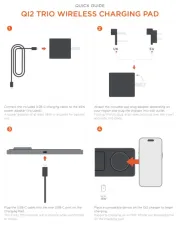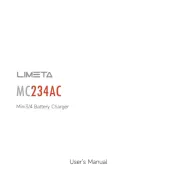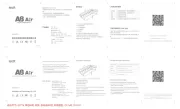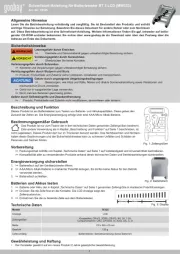Lindy 43058 Handleiding
Lindy
Batterij-oplader
43058
Bekijk gratis de handleiding van Lindy 43058 (2 pagina’s), behorend tot de categorie Batterij-oplader. Deze gids werd als nuttig beoordeeld door 49 mensen en kreeg gemiddeld 4.8 sterren uit 25 reviews. Heb je een vraag over Lindy 43058 of wil je andere gebruikers van dit product iets vragen? Stel een vraag
Pagina 1/2

ATX Power Supply Tester
User Manual English
Benutzerhandbuch Deutsch
Manuel Utilisateur Fançais
Manuale d’uso Italiano
LINDY No. 43058
www.LINDY.com
© LINDY ELECTRONICS LIMITED & LINDY-ELEKTRONIK GMBH - 2
nd
Edition - JAN 2008
English Manual
Deutsches Benutzerhandbuch
Permissible Range Indicated Range
(Min) (Max) (Min) (Max)
+5V +4.75V +5.25V 4.0V 6.0V
-12V -11V -13V -10V -14V
+12V1 +11V +13V +10V +14V
+12V2 +11V +13V +10V +14V
3.3V +3.14V +3.47V +2.0 +4.5V
5VSB +4.75V +5.25V +4.0V +6.0V
P.G. 100ms 900ms 0ms 990ms
Specifications
• Accurate voltage indicator (+/- 0.1V) tests:
o +12V1 / +5V / +3.3V / +5V / 5V Standby / +12V2 / -12V
• Connections:
o 20 Pin ATX PSU or 24 Pin ATX PSU
o 4P / 6P / 8P connector
o 5.25" type power / 3.5" type power / SATA power
• Low voltage, over voltage and no voltage, with audio alarms
• ATX PG (Power Good) value display
Operation
Important:
1. You must only connect one of the three 5.25”, 3.5” or a SATA
power connector to the unit at any one time,
2. Your ATX power supply must not be powered when
connecting and disconnecting any of the connectors.
1. Once all power connections have been made, switch on the
power. After switching on, you will hear two short beeps and the LCD
display will show the PG (Power Good) values. The value for PG
must be within a 100 to 900ms tolerance level.
2. If the PG values are out of tolerance or if there is no voltage
detected on one of the connectors, the unit will beep constantly. The
LCD screen will display LL on the affected connector.
3. The voltage level “ ” refers to the P4/P6/P8 connector only. +12V2
If there is no P4/P6/P8 plug attached, then "LL" will flash on the LCD
and the unit will constantly beep – anyhow, this is NOT an
indication for a faulty power supply!
If any voltage is lower or higher than the stated
Indicated Range
(see table), or not available, the LCD will only show "LL" or "HH"
respectively, indicating that the power supply is NOT OK.
A voltage within the Indicated Range will be displayed on the LCD.
20/24 Pin:
When either a 20 pin or 24 pin connector is attached, the values of
the voltage input will be shown on the LCD
P4/P6/P8:
When either a P4, P6 or P8 connector is attached, the values of the
voltage input will be shown on the LCD under +12V2
5.25”/3.5”/ SATA :
When a 5.25” or 3.5” connection is made, only the or SATA
+12V/+5V indicator lights will light to /+3.3V (+3.3V only for SATA)
show a correct voltage input.
Der Tester testet die Anschlüsse / Spannungen eines ATX Netz-
teils und zeigt an, ob Sie im Rahmen der Toleranzwerte liegen.
Ferner misst er, ob beim Einschalten des Netzteils alle Spannun-
gen in der vorgegebenen Zeitspanne aufgebaut werden (PG-
Wert). Daher müssen die ATX 20/24 Pol und einer der 4P/6P/8P
Stecker
VOR EINSCHALTEN
des Netzteils angeschlossen
werden.
Die SATA, 5,25“ und 3,5“ Anschlüsse können danach im laufenden
Betrieb angesteckt und geprüft werden.
HINWEIS: Schließen Sie von den drei SATA-, 5,25“- und 3,5“-An-
schlüssen keine der Stecker gleichzeitig an den Tester an. Testen Sie
diese immer einzeln.
HINWEIS: Ältere Netzteile hatten einen 20 Pol ATX Stecker, später
abgelöst durch einen 24Pol ATX Stecker. Oft finden sich heute 24 Pol
Stecker an denen seitlich ein 4 Pol Stecker abgeklippst werden kann,
so dass der ATX 20 Pol Stecker (für ältere Mainboards) übrig bleibt.
Beide Arten können angeschlossen werden.
Nach dem Einschalten ertönen zwei kurze Pieptöne und das LCD
Display zeigt die Spannungen an. Der Wert für muss im Bereich PG
100 bis 900ms liegen. Liegt er außerhalb, so baut das Netzteil die
Spannungen NICHT im vorgegebenen Zeitraum auf.
Werden ungewöhnliche Spannungen außerhalb der zulässigen
Toleranzwerte (siehe Tabelle: ) erkannt, so wird Permissible Range
ein Alarm (Piepton) ausgelöst. Die Alarm auslösenden Werte werden
durch Blinken am Display signalisiert.
Der Spannungswert bezieht sich auf die an +12V2 AUSSCHLIEßLICH
den P4/P6/P8-Steckern anliegende Spannung. Ist dort kein Stecker
angeschlossen, so blinkt in dieser Anzeige „ “ und der Alarmton wird LL
ausgelöst. Falls alle anderen Anzeigen im LCD Display korrekt
innerhalb der Toleranzwerte liegen, ist das ATX Netzteil in Ordnung.
Die Spannungswerte werden, sofern sie im (s. Angezeigten Bereich
Tabelle ) liegen, im LCD Display angezeigt, andern-Indicated Range
falls wird „ “ bei zu hoher oder „ “ bei zu niedriger oder ganz HH LL
fehlender Spannung angezeigt. Die Spannungswerte sind OK wenn
sie im (s. Tabelle ) liegen. Toleranzbereich Permissible Range
Wenn Ihr Netzteil 4 aufweist, prüfen mehrere P/6P/8P Anschlüsse
Sie diese bitte nacheinander einzeln bei angeschlossenem ATX 20/24
Pol Stecker. Schalten Sie dazu jeweils das Netzteil aus und ein.
Prüfen Sie nach Abschluss dieser Tests die SATA, 5,25“ und 3,5“
Anschlüsse. Lassen Sie dazu die ATX 20/24 Pol und einen der
P4/P6/P8 Stecker angeschlossen.
Schließen Sie nacheinander die SATA-, 5,25“- und 3,5“-Stecker
einzeln an und überprüfen Sie die LED Kontrollleuchten (+12V /
+3,3V / +5V) links neben dem LCD Display.
Für den SATA-Anschluss müssen alle 3 LEDs leuchten. (Falls Sie
diesen Stecker verkehrt herum anschließen hat er keinen Kontakt und
es werden keine Spannungen angezeigt.)
Für den 5,25“- und 3,5“-Anschluss müssen nur die +12V und +5V
LEDs leuchten.
For Home and Office Use
Tested to Comply with FCC Standards
SATA Connector
20/ 24 Pin PSU Connector
5.25” Connector
3.5” Connector
4P/ 6P/ 8P
Connector
+12V/+3.3V/+5V
Indicator

Specifications
• Accurate voltage indicator (+/- 0.1V) tests:
o +12V1 / +5V / +3.3V / +5V / 5V Standby / +12V2 / -12V
• Connections:
o 20 Pin ATX PSU or 24 Pin ATX PSU
o 4P / 6P / 8P connector
o 5.25" type power / 3.5" type power / SATA power
• Low voltage, over voltage and no voltage, with audio alarms
• ATX PG (Power Good) value display
WEEE
Waste of Electrical and Electronic Equipment,
Recycling of Electronic Products
Europe
In 2006 the European Union introduced regulations (WEEE) for the collection and
recycling of all waste electrical and electronic equipment. It is no longer allowable to
simply throw away electrical and electronic equipment. Instead, these products must
enter the recycling process.
Each individual EU member state has implemented the WEEE regulations into national
law in slightly different ways. Please follow your national law when you want to dispose of
any electrical or electronic products. More details can be obtained from your national
WEEE recycling agency.
Deutschland
Die Europäische Union hat mit der WEEE Direktive umfassende Regelungen für die
Verschrottung und das Recycling von Elektro- und Elektronikprodukten geschaffen.
Diese wurden im ElektroG in deutsches Recht umgesetzt. Dieses Gesetz verbietet vom
24.März 2006 an das Entsorgen Elektro- und Elektronikgeräten über die Hausmülltonne!
Diese Geräte müssen den lokalen Sammelsystemen bzw. örtlichen Sammelstellen
zugeführt werden! Dort werden sie kostenlos entgegen genommen. Die Kosten für den
weiteren Recyclingprozess übernimmt die Gesamtheit der Gerätehersteller.
LINDY No. 43058
© LINDY ELECTRONICS LIMITED & LINDY-ELEKTRONIK GMBH - 2
nd
Edition - JAN 2008
Manuel Utilisateur
Manuale d’uso
Permissible Range Indicated Range
(Min) (Max) (Min) (Max)
+5V +4.75V +5.25V 4.0V 6.0V
-12V -11V -13V -10V -14V
+12V1 +11V +13V +10V +14V
+12V2 +11V +13V +10V +14V
3.3V +3.14V +3.47V +2.0 +4.5V
5VSB +4.75V +5.25V +4.0V +6.0V
P.G. 0ms 990ms
Le testeur teste les prises/tensions d’une alimentation ATX
et montre si les résultats sont dans la plage de tolérance.
De plus, il mesure toutes les tensions de l’alimentation dans
un temps donné (Valeur PG).
Pour cela, les prises ATX 20/24 pins et 4P/6P/8P
doivent être
connectées/déconnectées le branchement de AVANT
l’alimentation ATX.
Les connecteurs SATA, 5,25“ et 3,5“ peuvent ensuite être testés et
connectés.
NOTE: ne connectez pas ensemble les 3 prises SATA, 5,25“ et 3,5“, sur
le testeur. Testez les toujours une par une.
NOTE: les anciennes alimentations avaient un connecteur ATX 20 pins,
qui a ensuite été changé en connecteur ATX 24 pins. On trouve souvent
des connecteurs ATX 24 pins sur lesquels une prise 4pins
supplémentaire est clipsée, pour que la compatibilité avec les prises
ATX 20 pins reste (anciennes cartes mère). Dans les deux cas de figure,
vous pouvez utiliser le testeur.
Après la connexion du testeur, 2 courts bips sonores sont émis et l’écran
LCD affiche les tensions. La valeur doit être entre . PG 100 et 900ms
Sinon les tensions de l’alimentation ne sont pas dans la plage de
tolérance (tension dans un temps donné).
Si les tensions sont en dehors de la tolérance (voir tableau: Permissible
Range), une alarme (bip sonore) sera émise. Les valeurs seront
affichées sur l’écran LCD.
La valeur de tension se réfère aux tensions +12V2 GENERALEMENT
des connecteurs P4/P6/P8. Si aucune prise n’est connectée au testeur,
l’indicateur “ “ clignote et une alarme sonore est émise. Si tous les LL
indicateurs de l’écran LCD sont compris dans la plage de tolérance,
l’alimentation ATX fonctionne correctement.
Les valeurs de tension s’afficheront sur l’écran LCD, si elles
correspondent à la plage de tolérance (voir tableau ). Indicated Range
Sinon l’indicateur “ “ s’affichera pour des surtensions, ou “ “ pour HH LL
des sous-tensions. Les valeurs de tension sont donc correctes tant
qu’elles sont comprises dans la plage de tolérance (voir tableau
Permissible Range).
Quand votre alimentation possède , plusieurs connecteurs P4/P6/P8
testez les un par un depuis le connecteur ATX 20/24 pins. Eteignez et
allumez à chaque fois l’alimentation.
Testez ensuite les connecteurs SATA, 5,25“ et 3,5“. Laissez les prises
ATX 20/24 pins et P4/P6/P8 connectés.
Connectez les prises SATA 5,25“ et 3,5“, une par une et contrôlez les
LEDs à gauche de l’écran LCD (+12V / +3,3V / +5V).
Pour les connecteurs SATA, les 3 LEDs doivent s’allumer. (Dans le cas
où ces connecteurs SATA sont montés à l’envers, aucune tension ne
sera affichée)
Pour les prises 5,25“ et 3,5“, les LEDs +12V et +5V LEDs doivent
s’allumer.
Specifiche
• Indicatore di voltaggio (+/- 0.1V):
o +12V1 / +5V / +3.3V / +5V / 5V Standby / +12V2 / -12V
• Connettori:
o 20 Pin ATX PSU o 24 Pin ATX PSU
o 4P / 6P / 8P
o 5.25" power / 3.5" power / SATA power
• Allarme acustico per voltaggio basso, alto o assente
• Display ATX PG (Power Good)
Istruzioni per l’uso
Importante:
1. Occorre collegare uno dei tre connettori di alimentazione da
5.25”, 3.5” o SATA
2. L’alimentatore ATX non deve essere acceso durante la
connessione e la disconnessione dei connettori.
1. Una volta collegata l’alimentazione, accendere l’alimentatore. Dopo
l’accensione, sentirete due brevi segnali acustici e il display mostrerà
il valore PG (Power Good). Questo valore deve essere entro il livello
di tolleranza da 100 a 900ms.
2. Se il valore PG non rientra nel livello di tolleranza oppure se non
viene rilevato alcun voltaggio, il tester emetterà continuamente un
segnale acustico. Sul display LCD apparirà LL in corrispondenza del
connettore sul quale viene rilevato l’errore.
3. Il livello di voltaggio “ ” è riferito solo al connettore P4/P6/P8.+12V2
Se non viene collegato alcun connettore P4/P6/P8, apparirà sul
display "LL" e l’unità emetterà continuamente un segnale acustico –
In questo caso NON significa che l’alimentatore è difettoso!
Se il voltaggio è inferiore o superiore a quello indicato nelle colonne
Indicated Range
(vedi tabella), o non rilevabile, sul display
apparirà rispettivamente solo "LL" o "HH", e ciò significa che
l’alimentatore è difettoso.
Il voltaggio apparirà sul display qualora rientrasse tra quelli indicati
nella tabella.
20/24 Pin:
Se si collega un connettore da 20 o 24 pin, il voltaggio in ingresso
verrà visualizzato sul display LCD.
P4/P6/P8:
Se si collega un connettore P4, P6 o P8, il voltaggio in ingresso verrà
visualizzato sul display LCD sotto +12V2.
5.25”/3.5”/ SATA :
Con connessioni da 5.25”, 3.5” , appariranno gli indicatori o SATA
+12V/+5V (+3.3V solo per SATA) per segnalare il corretto /+3.3V
voltaggio in ingresso.
Tested to comply with
FCC Standards.
For
Home and Office
use
SATA Connector
20/ 24 Pin PSU Connector
5.25” Connector
3.5” Connector
P4/P6/P8
Connector
+12V/+3.3V/+5V
Indicator
Product specificaties
| Merk: | Lindy |
| Categorie: | Batterij-oplader |
| Model: | 43058 |
| Ingebouwd display: | Ja |
| ATX Power connector (24-pin): | Ja |
| EPS power connector (8-pin): | Ja |
| Aantal SATA power connectors: | 1 |
| PCI Express power connectors (6-pin): | Ja |
| ATX Power connector (20-pin): | Ja |
Heb je hulp nodig?
Als je hulp nodig hebt met Lindy 43058 stel dan hieronder een vraag en andere gebruikers zullen je antwoorden
Handleiding Batterij-oplader Lindy

7 Juli 2023

24 Juni 2023
Handleiding Batterij-oplader
- Verbatim
- Metabo
- Promate
- Dolgin
- Graphite
- Westfalia
- Husqvarna
- EcoFlow
- Champion
- Kaco
- Megger
- Inateck
- Savio
- Stalco
- La Crosse Technology
Nieuwste handleidingen voor Batterij-oplader

29 Juli 2025

29 Juli 2025

29 Juli 2025

29 Juli 2025

29 Juli 2025

29 Juli 2025

29 Juli 2025

29 Juli 2025

28 Juli 2025

28 Juli 2025